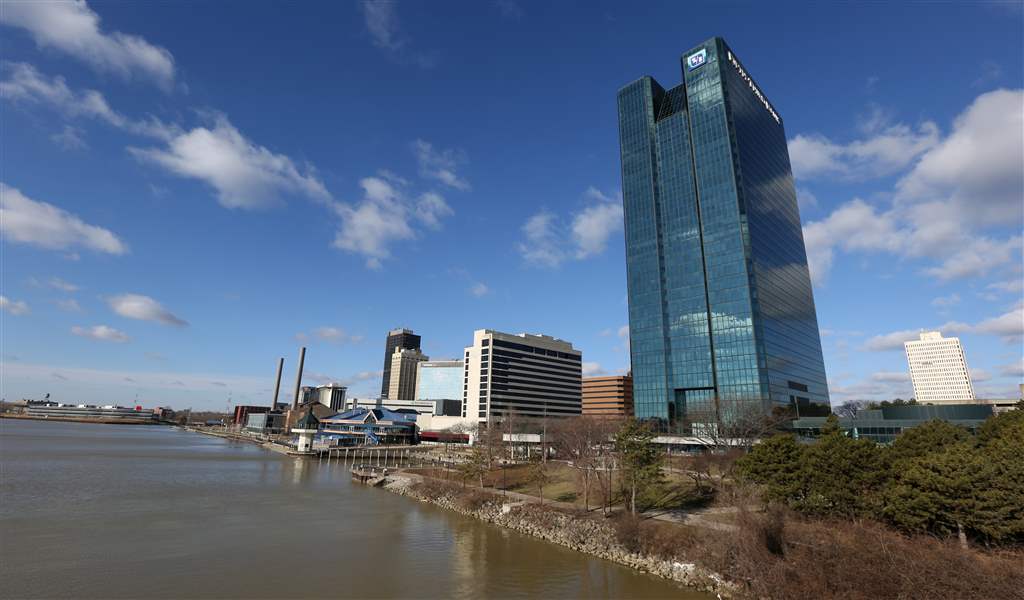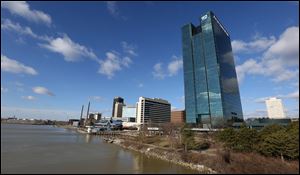
Toledo's population continues to decline, according to census estimate
3/22/2018
Downtown Toledo from the Maumee River. The U.S. Census Bureau reports that the populations of Lucas County and the Toledo metropolitan area have continued to slide.
The Blade/Dave Zapotosky
Buy This Image
The populations of Lucas County and the Toledo metropolitan area continued to slide last year while booming growth persisted in areas of the southern and western United States, the U.S. Census Bureau reported in its annual release of updated population estimates.
As of July 1, 2017, Lucas County’s population was about 430,887, down 1,325 from the year before, while the number of people living in the Toledo metro area was 603,668, down 923 from mid-2016, according to estimates released Thursday morning.
The county estimate is about 11,000 lower than the official census count from 2010, while the metro area’s population is estimated to have fallen by 6,333 during that time. For census purposes, the metro area includes Lucas, Fulton, and Wood counties.

Downtown Toledo from the Maumee River. The U.S. Census Bureau reports that the populations of Lucas County and the Toledo metropolitan area have continued to slide.
Dave Gedeon, vice president of transportation for the Toledo Metropolitan Area Council of Governments, said both numbers represent continuing migration from Toledo toward its suburbs.
“Nothing really rocks the world” in the estimates, he said. “It just seems like a continuing trend.”
Lucas County’s continuing population decline was offset in the metro area by continuing population growth in Wood County, whose estimated population rose by 788 to 130,492, while Fulton County’s estimated population declined only slightly, by 36 people.
Many Toledoans also migrated to Monroe County, which after six years of decline rebounded with a 426-person estimated increase to 149,223.
Elsewhere in the region, Ottawa, Defiance, and Hancock counties’ estimated populations all increased slightly, while the populations of Erie, Henry, Seneca, and Williams counties all were calculated to have dropped slightly.
The figures are estimates determined by a mathematical formula that uses past patterns tracked in birth, death, and tax records to predict population changes.
“I always take the census projections with a bit of a grain of salt,” Mr. Gedeon said. “Until they have a new decennial census [in 2020], I’m not using them for any planning studies.”

Dallas-Fort Worth, which added about 146,000 people, had the largest population growth of any metropolitan area while Maricopa County, Arizona — which includes the city of Phoenix — grew the most, 74,000, of any county, according to the census bureau.
“Historically, the Dallas metro area attracts large numbers from both international and domestic migration. Many of the other largest metro areas in the country rely mostly on international migration and natural increase for growth,” Molly Cromwell, a census bureau demographer, said in a statement.
Maricopa now has the United States’ fourth-highest population among 3,142 counties, behind Los Angeles County, California; Cook County, Illinois, and Harris County, Texas — home to Houston.
Cook County, home to Chicago, remained No. 2 even though it lost an estimated 20,093 residents — the most of any county in the nation. Other big losers among counties included Baltimore County, Maryland; Cuyahoga County, Ohio (Cleveland); St. Louis County, Missouri, and Allegheny County, Pennsylvania (Pittsburgh).
New York remains the nation’s largest metropolitan area, followed by Los Angeles, Chicago, Dallas-Fort Worth, and Houston. The highest percentage growth, however, mainly occurred far from big cities: in St. George, Utah; Myrtle Beach, S.C.; Greeley, Colo.; Bend, Ore., and Coeur d’Alene, Idaho. Of those only Greeley, near Denver, is associated with a major metropolitan area.
Contact David Patch at: dpatch@theblade.com or 419-724-6094.